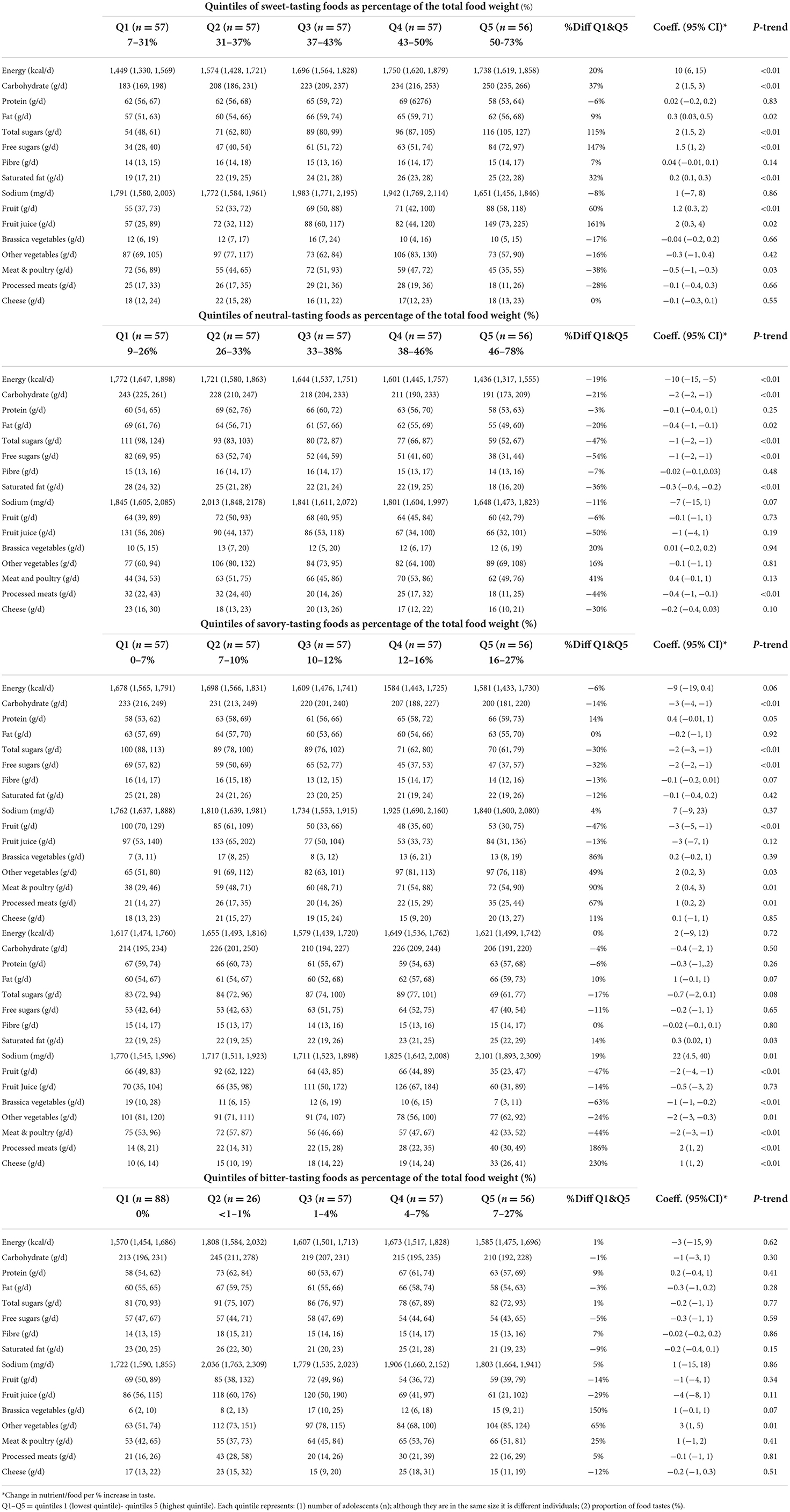- 1Nutritional Epidemiology Group, School of Food Science and Nutrition, University of Leeds, Leeds, United Kingdom
- 2Department of Food and Nutrition, Faculty of Human Sciences and Design, King Abdulaziz University, Jeddah, Saudi Arabia
A corrigendum on
Characterizing adolescents' dietary intake by taste: Results from the UK National Diet and Nutrition Survey
by Bawajeeh, A., Zulyniak, M. A., Evans, C. E. L., and Cade, J. E. (2022). Front. Nutr. 9:893643. doi: 10.3389/fnut.2022.893643
In the published article, there was an error in Table 2 as published. The rows for “neutral” and “savory” tastes are not separated in the published article, and are instead all combined under “neutral taste.” Moreover, the row headings for the rest of the table are all stated as “neutral taste” rather than being specified for the other tastes (savory, salty, and bitter). The corrected Table 2 and its caption appear below.

Table 2. Characteristics of adolescents' dietary intakes by the quintiles (Q) weight of foods consumed as a percentage of the total food weight.
A corrections has been made in Results, Neutral-Tasting Foods. The paragraph previously stated:
“Energy, carbohydrate, sugars, total fat and saturated fats all showed significant negative linear trends with increasing neutral-tasting foods. Energy intake decreased by 19% from the lowest to the highest quintile and there was a statistically significant negative trend of lower energy intake by 10 kcal/d (95% CI −15, −5; P < 0.001) for each increase in the proportion of neutral-tasting foods. Individuals in the highest quintile of neutral-tasting foods had lower carbohydrate (21%), total sugars (47%), and free sugars (54%) compared to those in the lowest quintile. Total fat and saturated fats intakes also showed negative overall trends of lower intakes with higher consumption of neutral-tasting foods. Processed meats consumption was 44% higher in the highest compared to the lowest quintile of neutral-tasting foods; with an overall significant trend (P < 0.01) per each percentage increase in neutral-tasting foods.”
The corrected paragraph appears below:
“Energy, carbohydrate, sugars, total fat and saturated fats all showed significant negative linear trends with increasing neutral-tasting foods. Energy intake decreased by 19% from the lowest to the highest quintile and there was a statistically significant negative trend of lower energy intake by 10 kcal/d (95% CI −15, −5; P < 0.001) for each increase in the proportion of neutral-tasting foods. Individuals in the highest quintile of neutral-tasting foods had lower carbohydrate (21%), total sugars (47%), and free sugars (54%) compared to those in the lowest quintile. Total fat and saturated fats intakes also showed negative overall trends of lower intakes with higher consumption of neutral-tasting foods. Processed meats consumption was 44% lower in the highest compared to the lowest quintile of neutral-tasting foods; with an overall significant trend (P < 0.01) per each percentage increase in neutral-tasting foods.”
The authors apologize for these errors and state that they do not change the scientific conclusions of the article in any way. The original article has been updated.
Publisher's note
All claims expressed in this article are solely those of the authors and do not necessarily represent those of their affiliated organizations, or those of the publisher, the editors and the reviewers. Any product that may be evaluated in this article, or claim that may be made by its manufacturer, is not guaranteed or endorsed by the publisher.
Keywords: taste, dietary taste, NDNS, adolescents, taste perception
Citation: Bawajeeh A, Zulyniak MA, Evans CEL and Cade JE (2022) Corrigendum: Characterizing adolescents' dietary intake by taste: Results from the UK National Diet and Nutrition Survey. Front. Nutr. 9:1046893. doi: 10.3389/fnut.2022.1046893
Received: 17 September 2022; Accepted: 12 October 2022;
Published: 16 November 2022.
Copyright © 2022 Bawajeeh, Zulyniak, Evans and Cade. This is an open-access article distributed under the terms of the Creative Commons Attribution License (CC BY). The use, distribution or reproduction in other forums is permitted, provided the original author(s) and the copyright owner(s) are credited and that the original publication in this journal is cited, in accordance with accepted academic practice. No use, distribution or reproduction is permitted which does not comply with these terms.
*Correspondence: Areej Bawajeeh, ZnNhb2JAbGVlZHMuYWMudWs=
 Areej Bawajeeh
Areej Bawajeeh Michael A. Zulyniak
Michael A. Zulyniak Charlotte E. L. Evans1
Charlotte E. L. Evans1